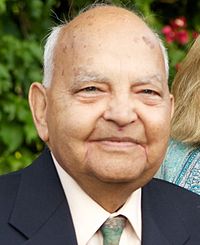- Dharam Ablashi
-
Dharam Ablashi (born October 8, 1931) is an American biomedical researcher born in India. He is best known for his co-discovery of Human herpesvirus 6 (HHV-6), an immunosuppressive and neurotropic virus that can cause encephalitis and seizures during a primary infection or when reactivated from latency in immunosuppressed patients[1]. He has contributed more than 85 papers on HHV-6, most of which appeared in top medical journals. He is internationally known for his research on Human and Simian herpesviruses and has also been a major contributor to research in HIV, EBV and the field of immunovirology.
Ablashi is currently the Scientific Director of the HHV-6 Foundation. Prior to joining the HHV-6 Foundation, he was Director of Herpesvirus Programs at Advanced Biotechnologies and Coordinator of DNA Virus Studies at the National Cancer Institute. An Adjunct Professor in microbiology at the Georgetown University School of Medicine, he co-edited the book Human Herpesvirus 6 and has authored or co-authored over 300 journal articles on herpes viruses[2]. He recently finished a term as President of the American Association for Chronic Fatigue Syndrome or AACFS (which is now called IACFS/ME), which he co-founded [3]. Ablashi also co-founded the International Association for Research on Epstein-Barr Virus and Associated Diseases and served for many years as Secretary, Treasurer and on the Board of Directors.
Contents
Background
Ablashi was born in Lahore, India and earned his Doctorate in Veterinary Medicine at Panjab University Veterinary College. He then received his Diploma in Bacteriology from the Indian Veterinary Research Institute before moving to the United States, where he earned his Master of Science degree in Pathology and Virology at the University of Rhode Island. After completing his post doctorate fellowship in the Department of Animal Pathology at the University of Rhode Island, Ablashi continued as a Research Associate at URI for one more year before working at Cobb Breeding Corporation as a microbiologist studying Marek's disease of chickens and later at Flow Laboratories. In 1969, Ablashi became a researcher at the National Cancer Institute. In 1986, while working in Dr. Robert Gallo’s lab, Ablashi, S. Zaki Salahuddin and Gallo together discovered HHV-6, later found to cause Roseola, an infantile disease [4].
He retired from NCI in 1992, but continued serving as an Adjunct Professor at Georgetown University and as consultant to various biomedical companies as well as NASA, W.H.O. and the United Nations. In 1994 he became Senior Scientist and then Director of Herpesvirus Programs at Advance Biotechnologies, Inc before becoming Scientific Director of the HHV-6 Foundation.
In 2005, Ablashi established the first ever extensive HHV-6 & 7 repository of reagents at the HHV-6 Foundation with the help of generous biospecimen donations from his international colleagues [5]. The Foundation makes these reagents available to any scientist and helps researchers interested in studying HHV-6 by offering pilot grants and consulting on HHV-6 matters.
Ablashi is also the co-inventor of four U.S. patents.
Recognition
Among the many distinguished awards received by Ablashi are the IACFS Rudy Perpich Memorial Achievement Award in 2007 [6], The Lifetime Achievement Award from the HHV-6 Foundation in Barcelona, Spain in 2006, and the Achievement Award from the HHV-6/HHV-7/HHV-8 International Conference in Paris, France in 2001.
Select Publications
- Krueger, G.R.F., Koch, B., and Ablashi, D.V. Persistent fatigue and depression in patients with antibody to human B-lymphotropic virus. Lancet 1:36, 1987
- Ablashi, D.V., Salahuddin, S.Z., Josephs, S.F., Imam, F., Lusso, P., Gallo, R.C., Hung, D., Lemp, J., and Markham, P.D. HBLV (or HHV6) in human cells. Nature 329:207, 1987
- Flamand L, Komaroff AL, Arbuckle JH, Medveczky PG, Ablashi DV. Human Herpesvirus-6: Basic Biology, Diagnostic Testing and Antiviral Efficiacy. J Med Virol 82, 1560-1568, 2010.
- Yao, K, Crawford JR, Komaroff AL, Ablashi DV, Jacobson S, Hman Herpesvirus-6 in Central Nervous System Diseases. J Med Virol. 82: 1669-1678, 2010.
- Ablashi DV, Devin CL, Yoshikawa T, Lautenschlager I, Luppi M, Kuhl U, Komaroff AL. Human Herpesvirus-6 in Multiple Non-Neurological Diseases. J Med Virol. in press 2010.
- Arbuckle JH, Medveczky MM, Luka J, Hadley SH, Luegmayr A, Ablashi D, Lund TC, Tolar J, De Meirleir K, Montoya JG, Komaroff AL, Ambros PF, Medveczky PG. The latent human herpesvirus 6A genome specifically integrates in telomeres of human chromosomes in vivo and in vitro. Proc Natl Sci USA. 107: 5563-5568. 2010.
Select Books
- Persistent Herpesvirus Infections. Current techniques for diagnosis. G.R.F. Krueger, D.V. Ablashi, and R.C. Gallo. J. Virological Methods, Volume 21, 1988.
- Human Herpesvirus-6: Epidemiology, Molecular Biology, and Clinical Pathology. D.V. Ablashi, G.R.F. Krueger, and S.Z. Salahuddin (editors), 1992. Published by Elsevier Science Publishers, B.V. Amsterdam-New York-Oxford.
References
- ^ Salahuddin, S.Z., Ablashi, D.V., Markham, P.D., Josephs, S.F., Sturzenegger, S., Kaplan, M., Halligan, G., Biberfeld, P., Wong-Staal, F., Kramarsky, B., and Gallo, R.C.: Isolation of a new virus, HBLV, in patients with lymphoproliferative disorders. Science 234:596-601, 1986
- ^ Human Herpesvirus-6. G.R.F.Krueger and D.V. Ablashi (editors), 2006. Published by Elsevier Science Publishers, B.V.Amsterdam – New York-Oxford.
- ^ IACFS/ME (http://www.iacfsme.org/FacultyBiographies/tabid/146/Default.aspx).
- ^ Yamanishi, K, Okuno, T, Shiraki, K, Takahashi, M, Kondo, T, Asano, Y., Kurata, T. Identification of human herpesvirus-6 as a causal agent for exanthem subitem. Lancet 331:1065-1067, 1988.
- ^ HHV-6 Foundation (http://www.hhv-6foundation.org/repository.htm)
- ^ IACFS/ME (http://www.iacfsme.org/FormerIACFSAwardees/tabid/209/Default.aspx)
Categories:- Living people
Wikimedia Foundation. 2010.

